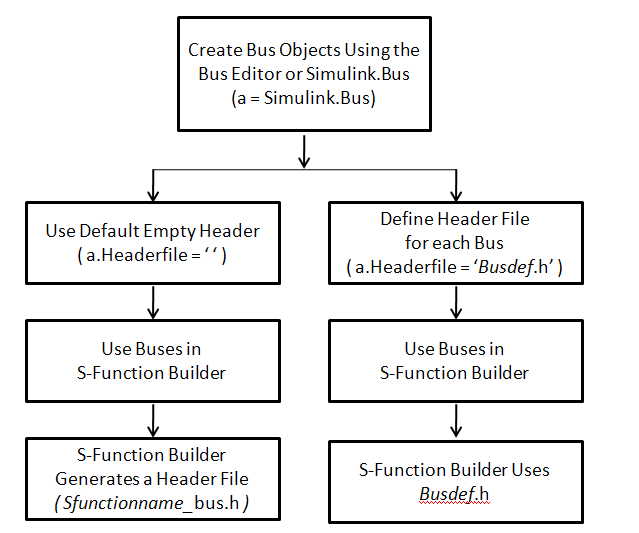Build S-Functions Automatically
About Building S-Functions Automatically
The S-Function Builder is a Simulink® block that integrates C/C++ code to build an S-function from specifications and C code that you supply. The S-Function Builder also serves as a wrapper for the generated S-function in models that use the S-function. This section explains how to use the S-Function Builder to build simple C MEX S-functions.
Note
For examples of using the S-Function Builder to build S-functions, see the C file
S-functions subsystem of the S-function examples provided with the Simulink product. To display the examples, enter sfundemos at the
MATLAB® command line (see S-Function Examples for more
information).
To build an S-function with the S-Function Builder:
Set the MATLAB current folder to the folder in which you want to create the S-function.
Note
This folder must be on the MATLAB path.
If you wish to connect a bus signal to the Input or Output port of the S-Function Builder, you must first create a bus object. You perform this task interactively using the Simulink Bus Editor (see Create and Specify Simulink.Bus Objects. Alternatively, you can use
Simulink.Busas follows.In the MATLAB Command Window, enter:
a = Simulink.Bus
As a result, the
HeaderFilefor the bus defaults to the empty character vector:a = Simulink.Bus Description: '' HeaderFile: '' Elements: [0x1 double]If you wish to specify the header file for the bus, then at the MATLAB command line:
a.Headerfile = 'Busdef.h'
If you do not specify a header file, Simulink automatically generates
Sfunctionname_bus.h

For a demonstration on how to use the S-Function Builder with a bus, see the
S-Function Builder with busesexample by entering the following command at the MATLAB command line:open_system(fullfile(matlabroot,'/toolbox/simulink/simdemos/simfeatures/',... 'sfbuilder_bususage'))
Create a new Simulink model.
Copy an instance of the S-Function Builder block from the User-Defined Functions library in the Library Browser into the new model.

Double-click the block to open the S-Function Builder dialog box (see S-Function Builder Dialog Box).

Use the specification and code entry panes on the S-Function Builder dialog box to enter information and custom source code required to tailor the generated S-function to your application (see S-Function Builder Dialog Box).
Click Build on the S-Function Builder to start the build process.
The S-Function Builder builds a MEX file that implements the specified S-function and saves the file in the current folder (see How the S-Function Builder Builds an S-Function).
Save the model containing the S-Function Builder block.
Deploying the Generated S-Function
To use the generated S-function in another model, first check to ensure that the folder containing the generated S-function is on the MATLAB path. Then copy the S-Function Builder block from the model used to create the S-function into the target model and set its parameters, if necessary, to the values required by the target model.
Alternatively, you can deploy the generated S-function without using the S-Function Builder block or exposing the underlying C source file. To do this:
Open the Simulink model that will include the S-function.
Copy an S-Function block from the User-Defined Functions library in the Library Browser into the model.
Double-click on the S-Function block.
In the Block Parameters dialog box that opens, enter the name of the executable file generated by the S-Function Builder into the S-function name edit field.
Enter any parameters needed by the S-function into the S-function parameters edit field. Enter the parameters in the order they appear in the S-Function Builder dialog box.
Click OK on the S-Function Block Parameters dialog box.
You can use the generated executable file, for example, the .mexw32
file, in any S-Function block in any model as long as the executable file is on the
MATLAB path.
How the S-Function Builder Builds an S-Function
The S-Function Builder builds an S-function as follows. First, it generates the following source files in the current folder:
sfun.cwhere
sfunis the name of the S-function that you specify in the S-function name field of the S-Function Builder dialog box. This file contains the C source code representation of the standard portions of the generated S-function.sfun_wrapper.cThis file contains the custom code that you entered in the S-Function Builder dialog box.
sfun.tlcThis file permits the generated S-function to run in Simulink Rapid Accelerator mode and allows for inlining the S-function during code generation. In addition, this file generates code for the S-function in Accelerator mode, thus allowing the model to run faster.
sfun_bus.hIf you specify any
Input portorOutput portas a bus in the Data Properties pane of the S-Function Builder dialog box, but do not specify a header file, then the S-Function Builder automatically generates this header file.
After generating the S-function source code, the S-Function Builder uses the
mex command to build the MEX file representation of the S-function from
the generated source code and any external custom source code and libraries that you
specified.